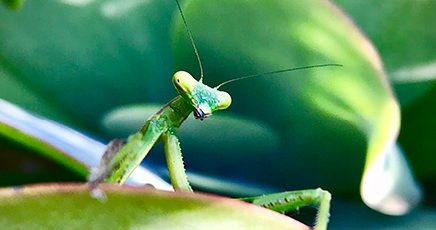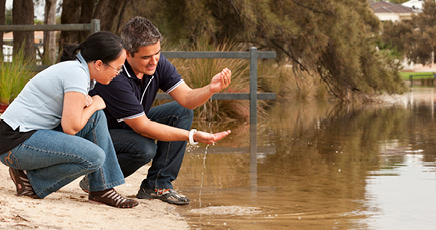STORY
Suyin and Tom count themselves very lucky to live in an area where they can hear the familiar sounds of Galahs on a daily basis. The park next to Suyin’s house is often visited by a vast amount of lizards, big and small, and they were convinced that there is a Wallaby in the area as they often see tracks and unusual pellets.
They are both aware that some of the children at their school live across the valley, in a recently developed area with lots of houses close to the shopping centre. They wonder whether the children who live there are as lucky as they are to see a habitat of wildlife in their local backyard.

Increased urbanization is reducing natural habitats across Australia, impacting on the survival of our native wildlife. Creating a native wildlife habitat is a great way to ensure the protection of native wildlife, from the smallest insects to birds, reptiles, mammals and frogs.
This learning activity is the first part of a sequence of 5 individual learning activities focused on creating a wildlife habitat. The order of these learning activities are: research, vision, design, planting and monitoring and care.
For children to:
- undertake research to determine what their local ecosystems are
- make observations to investigate local species and their habitat
- look at ways they can help create wildlife habitats
- enjoy being active and productive outdoors and build their social and teamwork skills
- understand the steps involved in creating a wildlife habitat.
This activity can be undertaken any time of the year.
Introduction
Creating a native wildlife habitat is a great way for kids to discover what is living in their backyard and local area. Not only will children learn about plant and animal species, they will understand the importance of urban habitats. The research phase is essential to discover the animals that already call your garden home.
We encourage our Junior Landcarers to learn more about wildlife habitats by exploring these other learning activities. These include the Creating a frog-friendly habitat sequence: research, design and construction, Creating a bee hotel sequence: research and construction as well as Building a nest box.
*Time allocation will be dependent on site selection and travel time. Additional time may be spent in consultation with your local Landcare group, council, or native plant nursery.
Checklist
Instructions
Step 1
Tuning in
To create a wildlife habitat, you need to know what animals live in your local area and the plants that make up their habitat. The best place to start is by making observations.
Look, listen and learn
Go outside, sit quietly and listen for 2 minutes. Using the Activity Sheet, circle in the urban and natural sounds and list any extra sounds you hear.
Now look around your backyard and local area. What is the main environment you see? Circle the one in the activity sheet that you think matches best.
Step 2
Delving deeper
Explore your garden or local park for 10 minutes. Remember to look on the ground, in the trees and shrubs, and up in the air.
There are lots of animals you might not see during the day. You can use a Field Guide (book/handout or an App for Australian Fauna identification) to help discover what other animals could be found in your local area.
Record the names of native animals you discover or research in the Activity Sheet. Tick if they were observed or found in the field guide.
Step 3
Honing in – looking for clues
What other evidence can you use to identify the animals in your local area? Discuss in a group what animal clues you have seen before.
Go outside to photograph or collect some animal clues. Tick off any animals clues you discover in the activity sheet. Remember to tread lightly so you don’t disturb animal homes.
Draw one of the tracks or traces you have discovered in the activity sheet.
Step 4
Processing and applying learning
Reflect and discuss – what have you learnt from looking more closely at species and habitats in your local area?
How would this be different if you looked in different seasons or even at different times of the day?
Biodiversity boosts ecosystem productivity; every species has an important role to play.
Watch one of the suggested videos in the reference list on biodiversity. Discuss why maintaining biodiversity is important.
Extension Activity
Research natural hazards that have affected your local area in the past: fire, floods and drought. Describe how these natural hazards may have impacted native wildlife and their habitat?
Start a Junior Landcare group can help kick-start some great biodiversity initiatives in your local areas and backyards. Find out more about how to start a Junior Landcare group. Check in with your local Landcare group or local council to find out if there is a community planting event coming up in your area.
Curriculum and Framework Links
SCIENCE
Year 3: ACSHE050, ACSIS053, ACSIS054, ACSIS057, ACSIS215, ACSIS060
Year 4: ACSSU075, ACSSU073, ACSIS064, ACSIS216, ACSIS071
Year 5: ACSSU043, ACSHE083, ACSIS231, ACSIS086, ACSIS090
Year 6: ACSSU094, ACSSU096, ACSHE098, ACSHE100, ACSIS221, ACSIS110
Year 7: ACSSU112, ACSSU116, ACSHE223, ACSHE120, ACSHE121, ACSIS125, ACSIS133
Year 8: ACSHE135, ACSHE136, ACSIS139, ACSIS145, ACSIS148
GEOGRAPHY
Year 7: ACHGK037, ACHGK038, ACHGK039, ACHGK040, ACHGK042, ACHGS050
Year 8: ACHGK051, ACHGK052, ACHGK053
HUMANITIES, ARTS & SOCIAL SCIENCES
Year 3: ACHASSK072
Year 5: ACHASSK114, ACHASSK118
HEALTH AND PHYSICAL EDUCATION
Year 3 & 4: ACPPS035, ACPPS038
Year 5 & 6: ACPPS056
Year 7 & 8: ACPPS073
ETHICAL UNDERSTANDING
Exploring values, rights and responsibilities
PERSONAL AND SOCIAL CAPABILITY
Social awareness
CURRICULUM CONNECTIONS
Outdoor Learning
CROSS CURRICULUM PRIORITY
Sustainability
MY TIME, OUR PLACE: FRAMEWORK FOR SCHOOL AGE CARE
Outcome 2 and 4
Reference List
ONLINE RESOURCES
Learn how school habitat gardens are important in providing habitat for native wildlife as well as being a great opportunity to teach students about biodiversity within their own school playground.
Explore seven different animal and plant habitats: coasts, freshwater, Antarctica, forests, woodlands, arid zone and urban, in this teachers guide from the Australian Museum.
Learn more about habitats in A Beginner’s Guide to Habitats from ThoughtCo.
Museum Victoria has developed a free National Field Guide app for Android and Apple devices. There are 8 apps available so choose one best suited to your location (NSW, ACT, VIC, SA, NT, QLD, WA & TAS).
QuestaGame is a mobile game using an app that gets players outdoors to engage with, learn about and help protect life on earth.
WATCH
In this CSIRO video learn about what biodiversity is and its importance. (8 minutes)
Watch this animated presentation from Ted-ED looking at the significance of having biodiverse environments. (5 minutes)
IMAGE ATTRIBUTION
Feature image:
Glossy grass skink courtesy of Upper Murray Landcare Network
Other images:
Photo of praying mantis by Jamie W. (2020 What’s in your backyard challenge Top 100)
We value your feedback
When you have finished this learning activity, please tell us what you think with our survey.
Your feedback will help Landcare Australia improve the activities in the Junior Landcare Learning Centre.
Why not try one of our other Junior Landcare learning activities?
Creating a butterfly garden
Biodiversity
Love Letters to the Land
Biodiversity|First Nations Perspectives|Food Production|Waste Management
Creating a sensory garden
Biodiversity
Understanding weeds: life cycle
Biodiversity


